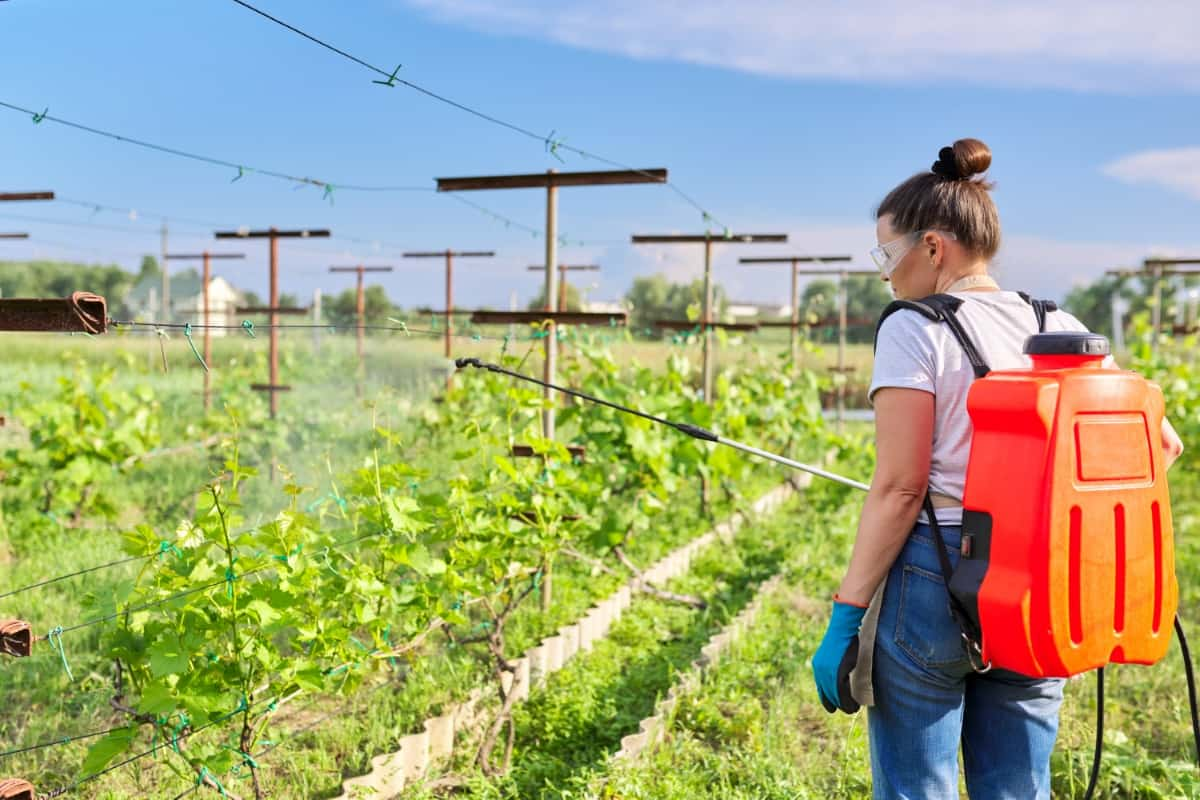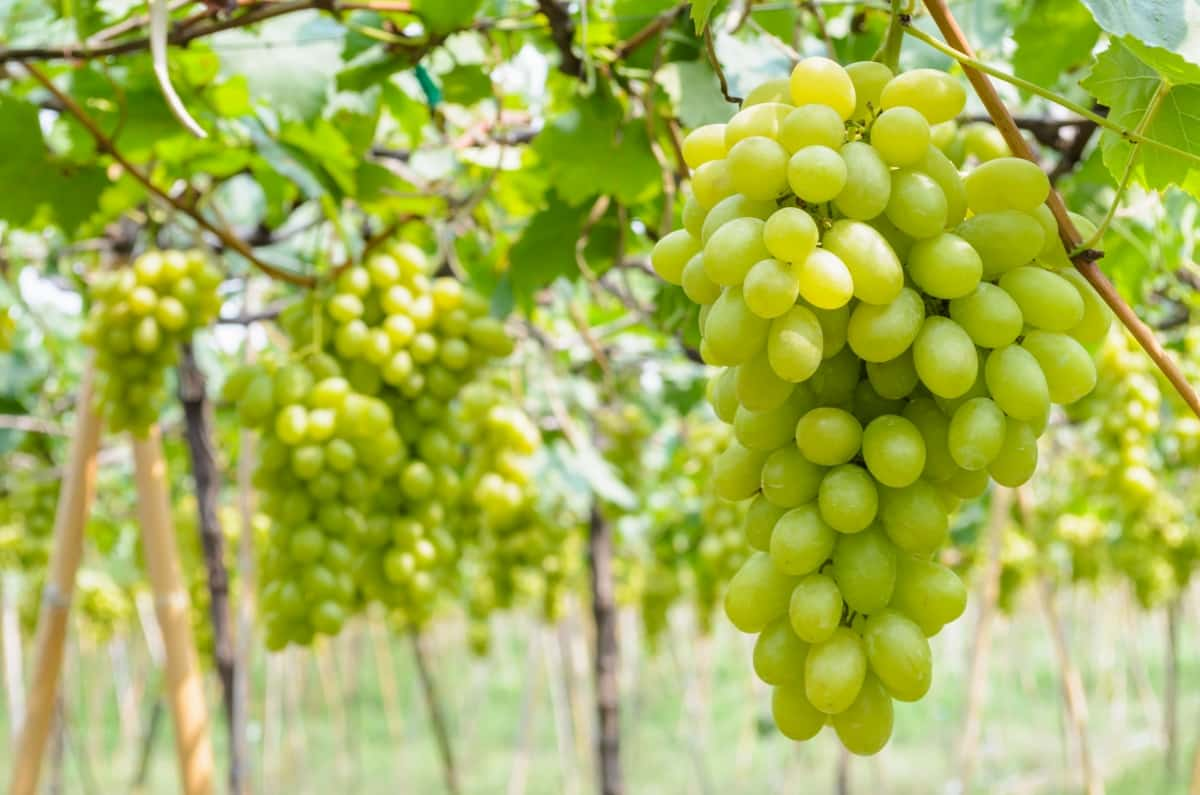Grape pests can pose a significant challenge to grape growers, as they can negatively impact the health and productivity of grapevines and, ultimately, the quality of the grapes produced. To combat these pests, many grape growers opt for natural and organic treatments that effectively control infestations while minimizing environmental and human health harm. In this guide, we’ll explore various methods to control grape pests using natural and organic treatments.

How to Control Grape Pests Naturally
Grape Pests: Identifying the Most Common Pests and Their Impact on Your Crop
Grape Phylloxera: Phylloxera is a tiny, sap-sucking insect that can cause extensive damage to grapevines by feeding on the roots and leaves. This can lead to stunted growth, reduced fruit quality, and even plant death. Look for galls on the leaves and roots, wilting vines, and yellowing leaves.
Grape Leafhoppers: Leafhoppers feed on grape leaves, causing stippling, yellowing, and reduced photosynthesis. They can also transmit diseases like Pierce’s, which can be fatal to grapevines. Look for small, wedge-shaped insects on the underside of leaves and monitor for leaf damage.
Grape Berry Moth: Berry moths lay their eggs on grape clusters, and the larvae feed on grape berries, leading to damaged and unmarketable fruit. Check for entry holes, webbing, and frass (insect waste) on grape clusters.
Japanese Beetles: Japanese beetles feed on grape leaves and can defoliate vines, reducing their photosynthesis ability. Severe infestations can lead to significant yield loss. Look for metallic green beetles with copper-colored wings on grape leaves.
Mealybugs: Mealybugs feed on grape clusters, reducing fruit quality, and can excrete honeydew, promoting the growth of sooty mold. Look for white, waxy, and segmented insects on grape clusters.
Using Neem Oil to Control Grape Pests: A Safe and Effective Method
Made from the neem tree seeds, Neem oil is a safe and effective natural method for controlling grape pests. It acts as a repellent, disrupting the feeding and reproductive processes of insects like aphids, mites, and leafhoppers. It also has antifungal properties, making it useful against diseases. To apply, dilute neem oil with water and spray it on the vines. This eco-friendly approach is non-toxic to humans beneficial insects, and wildlife, making it a sustainable choice for grape cultivation.
The Role of Beneficial Insects in Controlling Grape Pests: Introduction of Predatory Insects
Beneficial insects are crucial in controlling grape pests by acting as natural predators. Ladybugs, lacewings, parasitic wasps, and predatory mites are some examples of these helpful allies. These predators feed on common grape pests like aphids, mites, leafhoppers, and mealybugs, reducing their populations and preventing grapevine damage. Introducing and conserving these beneficial insects in vineyards helps maintain a balanced ecosystem, reducing the need for chemical pesticides.
In case you missed it: How to Control Cherry Pests Naturally: How to Get Rid of Them with Natural and Organic Treatment

Companion Planting: How Planting Certain Plants Together Can Deter Grape Pests
Companion planting involves strategically planting certain crops near grapevines to deter pests. Plants like marigolds, nasturtiums, and chives release natural compounds that repel common grape pests such as nematodes, aphids, and spider mites. Additionally, aromatic herbs like basil and mint can confuse pests with their strong scents, making it harder for them to locate the grapevines. This natural pest management technique creates a more diverse and balanced ecosystem in the vineyard, reducing the likelihood of pest infestations and promoting healthier grape plants.
Crop Rotation: How Rotating Your Grape Crop Can Help Control Pests
Crop rotation effectively controls grape pests by disrupting the life cycles of specific pests and diseases. By planting different crops in the same area where grapes were previously grown, pest populations that are host-specific to grapes are deprived of their preferred host plants. This reduces the build-up of pests and the risk of infestations in subsequent grape crops.
Additionally, crop rotation can improve soil health and reduce the accumulation of disease pathogens. By diversifying the crops in rotation, grape growers can minimize the need for chemical interventions, promote sustainability, and maintain a healthy vineyard environment.
Using Diatomaceous Earth to Control Grape Pests: A Non-Toxic and Organic Method
Diatomaceous Earth (DE) is a non-toxic and organic method for controlling grape pests. DE is composed of fossilized remains of diatoms and has abrasive properties that damage the exoskeleton of insects. When pests like slugs, snails, and certain soft-bodied insects come into contact with DE, they dehydrate and die.
In case you missed it: How to Control Lemon Pests Naturally: How to Get Rid of Them with Natural and Organic Treatment

It is a safe option for organic grape cultivation, as it doesn’t harm beneficial insects, humans, or the environment. DE can be applied as a barrier around grapevines or directly on the foliage to deter crawling pests. It is a sustainable and eco-friendly approach to pest management in vineyards.
Traps and Barriers: How to Use Traps and Barriers to Control Grape Pests
Traps and barriers are valuable tools in grape pest control. Pheromone traps, sticky traps, and colored traps can be strategically placed in vineyards to attract and capture specific pests like grape berry moths or grape leafhoppers. These traps disrupt the pest’s life cycle, reducing their populations.
Additionally, kaolin clay barriers can be applied to grape foliage, creating a physical barrier that deters pests and inhibits their feeding and egg-laying. Such eco-friendly methods reduce the need for chemical pesticides and contribute to sustainable grape production. Regular monitoring and trap placement should be tailored to specific pests and the vineyard’s unique characteristics.
Biological Control: How to Use Parasitic Wasps to Control Grape Pests
Parasitic wasps, such as leafhoppers and caterpillars, are effective biological control agents for grape pests. These wasps lay their eggs inside or on the host pests, and when the wasp larvae hatch, they consume the host, ultimately killing it. To use parasitic wasps in grape pest control, you can purchase and release them in your vineyard or create habitat conditions to encourage their presence. Providing nectar-rich flowers, shelter, and reduced pesticide use can attract and sustain parasitic wasp populations.
Integrated Pest Management (IPM): A Holistic Approach to Controlling Grape Pests
Integrated Pest Management (IPM) is a comprehensive strategy for grape pest control that combines multiple techniques to minimize the impact of pests while promoting sustainable and environmentally friendly grape cultivation. It involves monitoring and identifying problems, setting action thresholds, and employing a combination of biological control (beneficial insects), cultural practices (crop rotation, pruning), physical methods (traps, barriers), and judicious use of pesticides. IPM aims to maintain pest populations at levels that do not cause economic damage while reducing the reliance on chemical treatments.
In case you missed it: How to Control Guava Pests Naturally: How to Get Rid of Them with Natural and Organic Treatment

Conclusion
In conclusion, managing grape pests through natural and organic treatments effectively promotes sustainable and eco-friendly cultivation. These methods help protect both the environment and grape quality by reducing the need for chemical pesticides. Vineyard owners can control pests using these natural approaches while fostering healthier, more resilient grape crops.
- Beneficial Insects in Pest Management
- Natural Solutions for Pest Control in Flower Gardens
- Types of Fungicides Used in Agriculture
- Common Issues in the Fruit Development Stage of Pomegranate Farming
- Fruit Development Issues in Papaya: Easy Solutions and Treatment
- Soil-Borne Diseases and How to Protect Your Plants
- Practices to Prevent Disease Spread in the Garden
- From Wilted to Thriving: How to Treat Root Rot Naturally in Houseplants
- Natural Remedies to Cure Brown Spots on Fig Tree Leaves